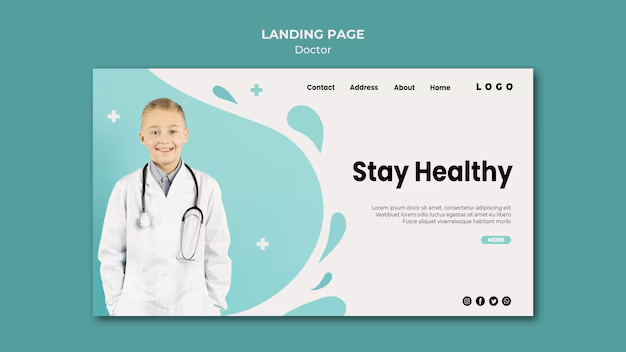In the competitive landscape of healthcare, a well-designed landing page can be a game changer for doctors looking to attract new patients. Unlike a standard website, a landing page is focused on a specific goal—converting visitors into patients. Whether you’re promoting a new service, offering a free consultation, or driving traffic from a marketing campaign, here’s how to create a doctor’s landing page that effectively converts visitors.

Table of Contents
Toggle1. Define Your Goal
Before you start designing your landing page, it’s essential to define its primary goal. Common objectives for a doctor’s landing page include:
- Booking appointments for a specific service (e.g., consultations, check-ups).
- Promoting a new treatment or procedure that you offer.
- Collecting patient information for newsletters or health tips.
Having a clear goal will guide your design and content choices throughout the process.
2. Craft a Compelling Headline
The headline is the first thing visitors will see, and it should grab their attention immediately. Consider these tips:
- Be Clear and Concise: Make sure your headline communicates the value of your offering. For example, “Schedule Your Free Consultation with Our Expert Pediatrician” is straightforward and enticing.
- Include Keywords: Use relevant keywords that potential patients might search for to improve SEO and ensure that your page appears in search results.
3. Engaging Visuals
Visual elements can significantly impact a visitor’s impression of your practice. Here’s how to use visuals effectively:
- High-Quality Images: Use professional images of your practice, staff, or services. Images of happy patients or your healthcare team can create a welcoming atmosphere.
- Videos: Consider including a short introduction video where you discuss your services or address common patient concerns. Video content can enhance engagement and build trust.
4. Compelling Content
Your landing page content should be informative and persuasive, highlighting the benefits of choosing your practice:
- Clear Descriptions: Provide clear and concise information about the services you offer. Focus on the benefits to the patient—how your services can solve their problems or improve their health.
- Patient Testimonials: Including quotes or reviews from satisfied patients can help build credibility and trust. Consider using a dedicated section for testimonials or integrating them throughout the page.
5. Strong Call to Action (CTA)
A clear and compelling call to action is crucial for converting visitors. Here are some tips for effective CTAs:
- Use Action-Oriented Language: Phrases like “Book Your Appointment Today” or “Get Your Free Consultation Now” encourage visitors to take immediate action.
- Make it Prominent: Your CTA should stand out on the page. Use contrasting colors, bold text, or buttons to draw attention.
- Place Multiple CTAs: Don’t limit yourself to a single CTA. Include them at strategic points on the page—after the introduction, in the middle of the content, and at the bottom.
6. Simple and Intuitive Design
The design of your landing page should be clean and straightforward, focusing on ease of navigation:
- Minimal Distractions: Avoid clutter. Keep the design focused on the content and CTA. Limit external links and other distractions.
- Responsive Design: Ensure your landing page looks great on all devices, including smartphones and tablets. Many patients will likely access your page via mobile.
7. Use Forms Wisely
If your goal is to collect patient information or schedule appointments, consider the following for your forms:
- Keep it Short: Only ask for essential information. The more fields you include, the less likely visitors will complete the form.
- Provide Options: If applicable, allow patients to choose appointment times or types of services directly through the form.
- Privacy Assurance: Include a note about how you protect their information, which can reassure visitors about data privacy.
8. Implement Trust Signals
Building trust is vital in the healthcare industry. Incorporate elements that reassure potential patients:
- Credentials and Certifications: Display your qualifications, board certifications, and any affiliations with professional organizations prominently.
- Privacy Policy: Include a link to your privacy policy to reassure visitors that their information is safe.
- Secure Payment Options: If applicable, mention secure payment options or insurance partnerships to make the process seamless for patients.
9. Analyze and Optimize
After launching your landing page, it’s important to monitor its performance and make improvements as needed:
- Use Analytics Tools: Tools like Google Analytics can provide insights into visitor behavior, conversion rates, and other key metrics.
- A/B Testing: Experiment with different headlines, CTAs, and layouts to determine what works best for your audience.
Conclusion
Creating a doctor’s landing page that converts involves a thoughtful approach to design, content, and user experience. By clearly defining your goals, crafting engaging content, and ensuring a seamless user experience, you can effectively turn website visitors into patients. Remember, the key to a successful landing page is to build trust and make it easy for potential patients to take action. As you refine your approach, focus on what resonates best with your audience and continuously optimize your landing page for better results.


No responses yet